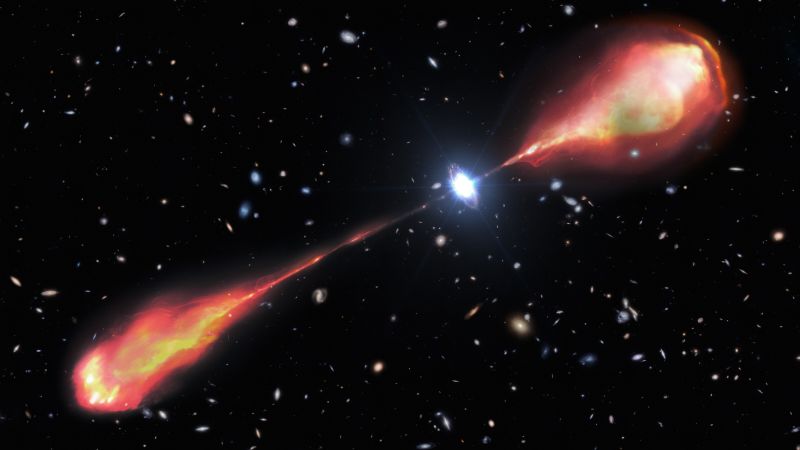In a groundbreaking revelation within the field of astrophysics, astronomers have identified an enormous radio jet located in the depths of the distant universe, measuring twice the width of the Milky Way galaxy. This extraordinary discovery indicates that the ancient jet emerged while the universe was still in its infancy, being less than 10% of its current age of approximately 13.8 billion years, as reported by the lead author of the study, Anniek Gloudemans, who is a postdoctoral research fellow at the National Science Foundation’s NOIRLab.
Historically, these colossal radio jets, which were formed shortly after the Big Bang, have proven elusive to astronomers. Gloudemans states that their absence had previously been linked to the cosmic microwave background—a remnant radiation from the early universe, which tends to obscure the faint radio signals from such distant formations. The complexities of how these jets are formed further complicate our understanding of them, making this discovery particularly significant.
Typically, supermassive black holes at the centers of large galaxies generate immense gravitational pull, consuming surrounding matter. This process can result in the release of exceptional amounts of energy, which in turn fuels the formation of quasars—the brightest entities in the cosmos. Quasars, identified as the luminous cores of ancient galaxies, are known to emit jets composed of energetic particles.
Utilizing a duo of advanced radio telescopes, including the Low Frequency Array (LOFAR), researchers have successfully observed this giant two-lobed jet, which stretches over 200,000 light-years. For context, a light-year represents the distance light travels in one year, equivalent to 5.88 trillion miles (9.46 trillion kilometers). The findings from this impressive study were published in “The Astrophysical Journal Letters” on February 6.
The methodology employed by astronomers allows them to effectively peer back in time, gaining insights into the early universe through the study of such distant phenomena. The discovery of this massive radio jet opens a window to understand the primordial cosmic conditions and provides clues regarding the formation of the first jets, alongside their influence on galaxy evolution over time.
The quasar responsible for this immense radio jet, designated J1601+3102, has an intriguing profile, having formed when the universe was merely 1.2 billion years old, approximately 9% of its present age. It can be classified as smaller than most quasars, weighing in at about 450 million solar masses, while typical quasars could exceed masses reaching billions of times that of our sun. Gloudemans notes that this indicates the remarkable possibility of generating powerful jets without necessitating an exceptionally large black hole.
The asymmetry of the double-sided jet is evidenced by variances in distance and brightness, suggesting that its lobes are influenced by extreme environmental factors. This intricate interplay raises questions about the dynamics surrounding the quasar.
In a concerted effort involving international collaboration, the radio jet was first detected through the LOFAR telescope network in Europe. Researchers subsequently conducted follow-up observations across various wavelengths, including near-infrared studies via the Gemini Near-Infrared Spectrograph in Hawaii and visible light observations using the Hobby-Eberly Telescope in Texas. This multidisciplinary approach yielded comprehensive insights into the expansive jet and its host quasar.
Further analysis suggests that the existence of such a large radio jet implies a treasure trove of similar cosmic phenomena remains yet to be uncovered. Gloudemans anticipates conducting additional observations to deepen the understanding of the unique environment surrounding J1601+3102. Critical questions remain, primarily concerning the conditions that lead to the formation of powerful radio jets.
Interestingly, another team of astronomers also utilizing LOFAR announced last fall the detection of a massive pair of jets dubbed Porphyrion, which spans a staggering 23 million light-years, outstripping the newly discovered jet by a significant margin. However, unlike J1601+3102, Porphyrion is situated 7.5 billion light-years away, placing it within the “nearby” universe rather than the earliest epochs.
The challenge of detecting jets as substantial as Porphyrion in the early universe is exacerbated by the cosmic microwave background’s interference. Nonetheless, the implications of this research are profound: they indicate that quasars, even during their formative periods as less massive entities, can still produce powerful jets, reshaping early cosmic environments through magnetism, heat, and cosmic rays—a phenomenon occurring not long after the Big Bang. This discovery holds implications for the development of galaxies and our broader understanding of cosmic evolution, showcasing the dynamic interplay of these primordial forces.












